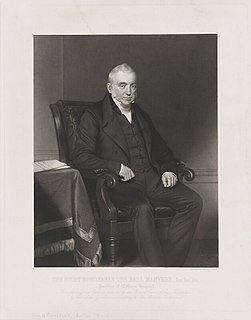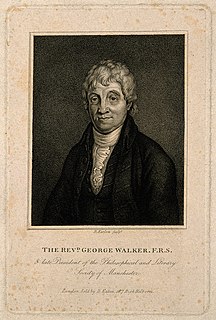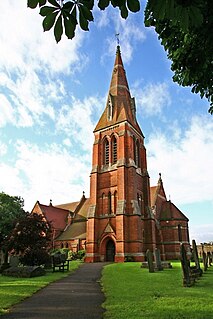
Nathan Haines was an English priest. He was born c.1735/6 and died 27 April 1806.

Nathan Haines was an English priest. He was born c.1735/6 and died 27 April 1806.
Nathan Haines came from Dorset. He was the son of the Rev. John Haines of Cattistock. Nathan's wife's cousin, Elizabeth Chudleigh was the wife of Evelyn Pierrepont, 2nd Duke of Kingston-upon-Hull, whose family had bought the living of St. Mary's in 1616, and this connection probably secured Haines the living in 1770.
His first wife was Susannah Chudleigh, daughter of George Chudleigh, and they were married at Cattistock, Dorset, England on 23 August 1766. There were three children from this union, Hugh Chudleigh, Elizabeth and Jane. After Susannah's death, he married Anne Tempest, daughter of Captain John Tempest of the 10th Royal Hussars, on 25 September 1780 at Tong, Yorkshire.
Nathan and Anne had one surviving child, Nathan Tempest Haines. [1]
He was ordained in 1761 and became vicar of St. Mary's Church, Nottingham on 24 March 1770 a position he held until he died. [2]
He was also Rector of Weston, 1770–1797, Curate of Holme Pierrepont, Nottinghamshire 1772 - 1799, Prebendary of Southwell 1788 - 1806, Perpetual Curate of Tong, Yorkshire 1789 - 1806, Domestic Chaplain to Viscount Newark (later Earl Manvers) 1796 - 1806, Rector of Cotgrave, Nottinghamshire 1797 - 1806
Although Nottingham was a strong dissenting town, relationships between Anglicans and Dissenters were largely cordial; many dissenters attending chapel and receiving communion in their parish church. It was widely recognised that the poor of the town received more charity from the Anglican clergy than from any of the dissenting ministers.
In 1801, the Nottingham Journal published figures for St. Mary's - 3,872 inhabited houses, 5,312 families, 10,895 males and 11,759 females, giving a parish population of 22,654. This was double the figure in 1770 when Haines took the living.
During Haines incumbency, the cordial relations between Anglicans and dissenters deteriorated. In 1799, shots were fired through the vicarage bedroom window, "manifestly with a destructive and malicious intent" while Dr and Mrs Haines were asleep in bed. The Vicarage was Washington House, on High Pavement.
In 1800, the Nottingham Journal reported loitering, gaming and other nuisances in the churchyard during divine service. In 1801, the vestry demanded the restoration of the right to elect one of the churchwardens, and "during this time some highly reprehensible irregularities were committed in the church". The election of a sexton in 1805 turned into a party-political affair with the parading of rival banners. By 1806, the year of Haines death, railings were erected around the churchyard with lockable gates and the age-old footway across the churchyard dug-up and discontinued. He had become a Doctor of Divinity (DD).

Thomas Secker was the Archbishop of Canterbury in the Church of England.
A vicar is a representative, deputy or substitute; anyone acting "in the person of" or agent for a superior. Linguistically, vicar is cognate with the English prefix "vice", similarly meaning "deputy". The title appears in a number of Christian ecclesiastical contexts, but also as an administrative title, or title modifier, in the Roman Empire. In addition, in the Holy Roman Empire a local representative of the emperor, perhaps an archduke, might be styled "vicar".

Gilbert Wakefield (1756–1801) was an English scholar and controversialist. He moved from being a cleric and academic, into tutoring at dissenting academies, and finally became a professional writer and publicist. In a celebrated state trial, he was imprisoned for a pamphlet critical of government policy of the French Revolutionary Wars; and died shortly after his release.

George Anthony Denison (1805–1896) was an English Anglican priest. He served as Archdeacon of Taunton from 1851.

Granby is a small village in the Rushcliffe district of Nottinghamshire, England. It lies in the Vale of Belvoir.

Charles Herbert Pierrepont, 2nd Earl Manvers was an English nobleman and naval officer, the second son of Charles Pierrepont, 1st Earl Manvers.
Rev. Scrope Berdmore was an English clergyman.
Henry Cantrell was a high-church Church of England clergyman and religious controversialist.
Charles James Hoare was an evangelical Church of England clergyman, archdeacon of Surrey.
George Wilkins, D.D. (1785-1865) served as a priest in the Church of England and was Archdeacon of Nottingham.
Joshua William Brooks, M.A. was born in 1790 and died 15 February 1882: he was a priest in the Church of England.

St. Stephen's Church, Sneinton is a parish church in the Church of England.

St Michael and All Angels' Church, Elton on the Hill is a parish church in the Church of England in Elton on the Hill, Nottinghamshire. It is Grade II listed by the Department for Digital, Culture, Media and Sport as a building of special architectural interest.
Francis Morse, M.A. was a priest in the Church of England.

George Walker was a versatile English Dissenter, known as a mathematician, theologian, Fellow of the Royal Society, and activist.

John Disney (1746–1816) was an English Unitarian minister and biographical writer, initially an Anglican clergyman active against subscription to the Thirty Nine Articles.

High Pavement is a street in Nottingham, England. It is one of the earliest streets in the city, and most of its buildings are listed.
St. Ann's Church, St. Ann's Well Road was a Church of England church in Nottingham on St. Ann's Well Road between 1864 and 1971.

All Saints' Church, Winthorpe is a Grade II listed parish church in the Church of England in Winthorpe, Nottinghamshire, England. The current building, the construction of which was completed in 1888, is at least the third version of the church, which dates back to at least the early 13th century. All Saints' Church was commissioned by the church rector, Edward Handley, in memory of one of his relatives.
Charles Jerram (1770–1853) was an English evangelical priest of the Church of England.